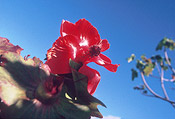Why is this species important?
Kokia drynarioides is a tree found in Hawaii's dry forests. Almost 90% of these forests have been destroyed and with them 10% of Hawaii's native plants. The loss of this habitat has resulted in the designation as endangered of many of the Hawaiian honeycreepers, birds unique to Hawaii, which have co-evolved with many Hawaiian plants.K. drynarioides is a spectacular member of the hibiscus family. It is a small tree that grows to 10 m and has star-shaped leaves and large red flowers. It is well established in cultivation following the dispersal of large numbers of seeds to botanical gardens all over the world in the early 1900s and is sometimes used as a garden and ornamental plant.
Where is it found?
K. drynarioides is found only on the island of Hawaii in the central Pacific Ocean. A few individuals grow in the dry forest on the lava fields at Pu'u Wa'awa'a and Kaupulehu in the North Kona district. Only four individuals are known from the North Kona district and the species is not reproducing in the wild.
How do people use it?
Traditionally Hawaiians have used the bark of K. drynarioides to make red dye that is used to colour fishnets. It is also used as a medicine to prevent thrush.
Why is it threatened?
In the early 1900s collectors had already declared K. drynarioides to be "exceedingly rare". In 1984 it was listed as Endangered under the US Endangered Species Act. At that time it was known from a single population of 15 individuals. K. drynarioides is one of only three threatened and endangered Hawaiian plants (out of 293) for which the US Fish and Wildlife Service has designated habitat critical to the survival and recovery of the species. Extensive grazing has resulted in the loss of trees and habitat for K. drynarioides. The tree is still threatened by the continued browsing of domestic cattle and feral animals that has prevented the growth and establishment of young trees. Wildfires are a threat to the remaining trees. Fountain grass Pennisetum setaceum is an alien species that has now covered the once barren lava substrate. It helps to fuel wildfires as well as competing with native tree seedlings for light and water.
What conservation action is needed?
Following the designation of critical habitat for K. drynarioides, management goals include the reduction of threats of fire and damage by animals, habitat improvement to encourage natural regeneration and the planting of trees that have been raised in nurseries. The state and federal government is also considering an alternative route for a proposed saddle road realignment that will avoid rare dry forest and habitat for K. drynarioides.
Selected references
Wagner, W., Herbst, D. and Sohmer, S., 1990. Manual of the flowering plants of Hawaii. University of Hawaii, Bishop Museum Press, Honolulu. 1853 pp.
Local contacts
National Tropical Botanical Garden
3530 Papalina Road
Kalaheo
Kauai
Hawaii 96741
Tel: 808 332 7324
Fax: 808 332 9765
Amy Greenwell Ethnobotanical Garden
Mr. Peter Van Dyke, Manager
P O Box 1053
Captain Cook
Hawaii 96704
Tel: 808 323 3318
Hawaii District
Division of Forestry and Wildlife
Mr. Lyman Perry
P O Box 4849
Hilo
Hawaii 96720
Tel: 808 974 4381
|
 |

|